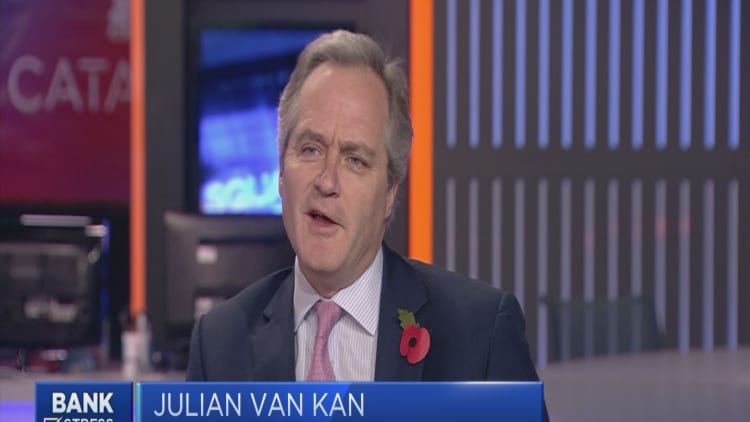
Italian banks will be under particular scrutiny by investors Friday, as European regulators prepare to release their latest assessment of European-based banks.
The entire European banking sector is down more than 23 percent in the last 12 months. But in Italy the picture is even more negative. The FTSE Italy banking index is down 22 percent since the start of the year and 34 percent lower from a peak on April 24.
Italian banks have been hit by market concerns over the country's politics. The anti-establishment government, which took power in June, has promised to increase public spending in the coming year, raising worries about the stability of the Italian economy given its massive debt pile.
Domestic banks hold significant amounts of government bonds. Italian banks holdings of local government bonds stood at 10.7 percent in March of this year, a note from ABN AMRO said. As a result, the increase in bond yields on the back of concerns over Italy's politics have brought problems for Italian banks. This is because when yields rise it means there's a higher perceived risk. It also means that the chances of seeing a return on their Italian bonds are reduced. So, troubled times for Italian debt also extends to those holding it too.
There is "the risk of a double whammy," Ricardo Garcia, chief euro zone economist at UBS told CNBC via email, ahead of Friday's results.
"Banks are already under pressure due to losses on their Italian BTP holdings. If you add potential issues in ECB bank stress tests, the banks would be under pressure from two sides," he explained.
Out of the 48 banks under analysis, four are Italian. They are: UniCredit, Intesa Sanpaolo, Banco BPM and Unione di Banche Italiane.
"The Italian banking sector will be under particularly scrutiny given market concerns about the still relatively high stock of non-performing loans," Fabio Trussardi, banking analyst at UBS Global Wealth Management, told CNBC via email.
The European Banking Authority (EBA) said in a report that non-performing loans (NPLs) have fallen in the last year, coming down to an average of 3.6 percent in the second quarter of this year across the region. However, the same report showed that the ratio of NPLs in Italy was 9.7 percent in the same period, much higher than the EU average.
"While this year macro assumptions will be harsher, we would expect an overall reassuring set of results," Trussardi said about Italy's banks. He noted that the NPL ratio, though high, has come down from last year and the macro assumptions for Italy are not particularly harsh compared to other countries.

Credit rating agency DBRS suggested in a note on Wednesday that the stress tests could have gone one step further in forecasting the banks' performance during an adverse scenario.
"Even though the euro zone architecture has strengthened to face a new sovereign crisis, countries may experience yields rising more than the ones assumed in the 2018 exercise," the agency said.
"For example, Italy's 10-year sovereign bond yield, despite still benefiting from the quantitative easing, has increased on average by around 100 basis points since May 2018. This compares to the maximum shock of 120 basis points outlined in the 2018 stress test scenario," DBRS noted.
Imagining a scenario where yields on European debt rise is not farfetched. The European Central Bank is due to end its quantitative easing program — by which it purchases European bonds every month to boost the European economy — in December. This means that without the ECB's presence in the market as of January, European bond yields could rise.
"We are not short on any Italian banks at present and think the EU has everything to gain in the short term from a degree of fudge," Colin McLean, CEO at SVM Asset Management, told CNBC via email.
"I don't think the market will get much useful information from the tests other than for the very property exposed ones," he said, adding that "the risks to banks and the European economy is more competition for deposits and a squeeze on borrowing by second tier credit corporates."


